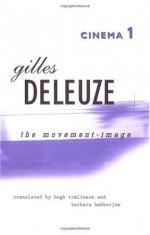|
This section contains 429 words (approx. 2 pages at 400 words per page) |

|
The Perception-Image Summary and Analysis
The two poles, objective and subjective address the issue that perception has objective and subjective dimensions. For example, Gance's "La Roue" presents a subjective view of a pipe through the damaged eyes of a character by the camera's soft focus that is called sensory factor. Other factors used to illustrate perception include an active factor to show the views of a participating character and an affective factor that shows a view for effect. These views are qualified by comparison to a "modified, restored image" that is assumed to be objective. The author defines "objective" as a view of someone external to the set but clarifies his view with Jean Mitry's idea of "being-with" that Dos Passos calls "eye of the camera" or the view of someone who is not identified as one of the characters. Other philosophers of the...
(read more from the The Perception-Image Summary)
|
This section contains 429 words (approx. 2 pages at 400 words per page) |

|




